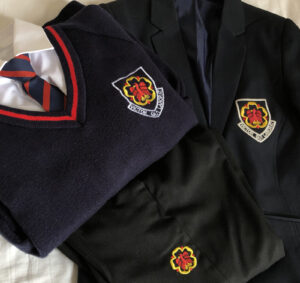 As lockdown restrictions are slowly being lifted, the majority of students are expected to return to school in September, welcome news for garment suppliers, printers and embroiderers alike. Here, Natalie Greetham, senior marketing co-ordinator at Madeira UK, outlines how to choose the correct backing for embroidering schoolwear.
As lockdown restrictions are slowly being lifted, the majority of students are expected to return to school in September, welcome news for garment suppliers, printers and embroiderers alike. Here, Natalie Greetham, senior marketing co-ordinator at Madeira UK, outlines how to choose the correct backing for embroidering schoolwear.
When dealing with school uniforms, one of the biggest challenges can be that the logo is often required to be reproduced across a variety of different garments from polo shirts, trousers and skirts to knitwear and stretchy sports fabrics.
For the design to successfully translate across a range of garments, digitising plays a key role and should be based on the specific fabrics and their characteristics. Always discuss with your digitiser the type of garments the design will be going onto, they will then be able to make the necessary adjustments, i.e. adding an extra layer of underlay for flimsy or stretchy items or stitching from the centre outwards for large fill areas to avoid push and pull distortion.
When faced with such a diverse range of fabrics, often varying in quality, another vital consideration is selecting the correct backing to stabilise the fabric ready for embroidery. But how do you know which backing to use when there are so many to choose from?
Whether you choose a cut away or tear away backing will be determined by the fabric you are going to embroider onto, followed by the style and stitch count of the embroidery design. The stability or stretch of the fabric will determine the amount of stability required and remember to use a maximum of three layers or switch to a heavier backing.
Most fabrics fall within these main categories;
- Knitted fabrics: These will stretch in all directions and are particularly unstable. For these fabrics, select a soft cut away backing, such as Madeira’s PS89 to help control the stretch and prevent distorsion.
- Lightweight woven fabrics: These fabrics, such as dress shirts and silk, are light but are typically not stretchy so will also require a cut away stabiliser. A no-show backing, such as Madeira’s Weblon is a good option here, it’s soft next to the skin and won’t show through fine fabrics.
- Tightly woven heavyweight fabrics: These fabrics, such as denim, corduroy and canvas, have minimal stretch and won’t need as much stabilisation, a medium 40g tear away backing is a suitable choice here.
- Performance wear fabrics: always think ‘light’ and avoid a high stitch count. These fabrics are often extremely thin, stretchy, slippery to hoop and generally a nightmare for most embroiderers. Don’t be put off, there are products out there like Weblon, designed specifically to combat these problems. A single piece will usually be sufficient for a school logo, however, if the design has over 8,000 stitches a second layer can be added. For inferior quality polos try a single piece of Weblon hooped next to the garment with a piece of 40g tear away, often a real problem solver.
So, don’t be tempted to skimp on backing, a good quality stabiliser can make a huge difference to the outcome of your embroidery and spending that little bit extra really will yield the best results, happy customers become repeat customers.
 Printwear & Promotion The Total Promotional Package
Printwear & Promotion The Total Promotional Package




